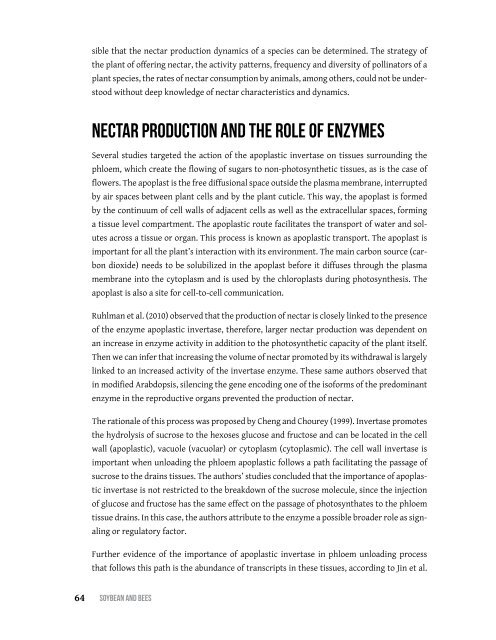Soybean and Bees
You also want an ePaper? Increase the reach of your titles
YUMPU automatically turns print PDFs into web optimized ePapers that Google loves.
sible that the nectar production dynamics of a species can be determined. The strategy of<br />
the plant of offering nectar, the activity patterns, frequency <strong>and</strong> diversity of pollinators of a<br />
plant species, the rates of nectar consumption by animals, among others, could not be understood<br />
without deep knowledge of nectar characteristics <strong>and</strong> dynamics.<br />
Nectar production <strong>and</strong> the role of enzymes<br />
Several studies targeted the action of the apoplastic invertase on tissues surrounding the<br />
phloem, which create the flowing of sugars to non-photosynthetic tissues, as is the case of<br />
flowers. The apoplast is the free diffusional space outside the plasma membrane, interrupted<br />
by air spaces between plant cells <strong>and</strong> by the plant cuticle. This way, the apoplast is formed<br />
by the continuum of cell walls of adjacent cells as well as the extracellular spaces, forming<br />
a tissue level compartment. The apoplastic route facilitates the transport of water <strong>and</strong> solutes<br />
across a tissue or organ. This process is known as apoplastic transport. The apoplast is<br />
important for all the plant’s interaction with its environment. The main carbon source (carbon<br />
dioxide) needs to be solubilized in the apoplast before it diffuses through the plasma<br />
membrane into the cytoplasm <strong>and</strong> is used by the chloroplasts during photosynthesis. The<br />
apoplast is also a site for cell-to-cell communication.<br />
Ruhlman et al. (2010) observed that the production of nectar is closely linked to the presence<br />
of the enzyme apoplastic invertase, therefore, larger nectar production was dependent on<br />
an increase in enzyme activity in addition to the photosynthetic capacity of the plant itself.<br />
Then we can infer that increasing the volume of nectar promoted by its withdrawal is largely<br />
linked to an increased activity of the invertase enzyme. These same authors observed that<br />
in modified Arabdopsis, silencing the gene encoding one of the isoforms of the predominant<br />
enzyme in the reproductive organs prevented the production of nectar.<br />
The rationale of this process was proposed by Cheng <strong>and</strong> Chourey (1999). Invertase promotes<br />
the hydrolysis of sucrose to the hexoses glucose <strong>and</strong> fructose <strong>and</strong> can be located in the cell<br />
wall (apoplastic), vacuole (vacuolar) or cytoplasm (cytoplasmic). The cell wall invertase is<br />
important when unloading the phloem apoplastic follows a path facilitating the passage of<br />
sucrose to the drains tissues. The authors’ studies concluded that the importance of apoplastic<br />
invertase is not restricted to the breakdown of the sucrose molecule, since the injection<br />
of glucose <strong>and</strong> fructose has the same effect on the passage of photosynthates to the phloem<br />
tissue drains. In this case, the authors attribute to the enzyme a possible broader role as signaling<br />
or regulatory factor.<br />
Further evidence of the importance of apoplastic invertase in phloem unloading process<br />
that follows this path is the abundance of transcripts in these tissues, according to Jin et al.<br />
64 SoybeAn <strong>and</strong> bees


